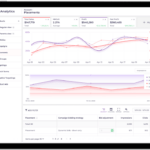What is amazon ppc campaign

Amazon PPC (Pay-Per-Click) campaign is a powerful advertising tool for sellers looking to enhance their product visibility and increase sales on the Amazon platform. It allows sellers to bid on keywords relevant to their products, and their ads appear at the top of search results and on product detail pages. But let’s dive deeper into what Amazon PPC entails and how it can benefit sellers like you.
Introduction to Amazon PPC
What is Amazon PPC?
Amazon PPC, or Pay-Per-Click, is an advertising model where sellers pay a fee each time their ad is clicked. It’s a way for sellers to promote their products to potential customers on Amazon and drive traffic to their product listings.
Importance of PPC for Amazon Sellers
With millions of products on Amazon, competition can be fierce. Amazon PPC offers sellers a way to stand out from the crowd and reach customers who are actively searching for products similar to theirs. It helps increase visibility, drive traffic, and ultimately boost sales.
How Amazon PPC Works
Amazon PPC operates on a bidding system where sellers bid on specific keywords related to their products. When a shopper searches for those keywords, Amazon’s algorithm determines which ads to display based on relevance and bid amount.
Basics of Amazon PPC
Keyword Targeting
Keywords are the foundation of Amazon PPC campaigns. Sellers select keywords that are relevant to their products and target them in their ads to ensure their products appear in relevant search results.
Bidding System
Sellers set a maximum bid amount for each keyword, which represents the highest amount they’re willing to pay for a click. The bidding system determines the ad’s placement and visibility based on the bid amount and ad relevance.
Setting Up Your Amazon PPC Campaign
To start using Amazon PPC, sellers need to create an account on Amazon Seller Central. From there, they can choose the type of campaign they want to run, set a budget and duration, and select keywords to target.
Choosing the Right Campaign Type
Amazon offers three main types of PPC campaigns: Sponsored Products, Sponsored Brands, and Sponsored Display. Each type has its own benefits and targeting options, allowing sellers to tailor their campaigns to their specific goals.
Keyword Research for Amazon PPC
Keyword research is crucial for the success of an Amazon PPC campaign. Sellers need to identify the most relevant and high-performing keywords for their products to maximize their ad’s visibility and reach.
Tools for Keyword Research
Several tools are available to help sellers conduct keyword research, including Amazon’s own search term reports, third-party keyword research tools, and competitor analysis.
Selecting Relevant Keywords for Your Products
Sellers should focus on selecting keywords that are highly relevant to their products and have a high search volume. They should also consider the competition for each keyword and its potential to drive sales.
Creating Compelling Ad Copies
Once sellers have selected their keywords, they need to create compelling ad copies that entice shoppers to click on their ads and learn more about their products.
Crafting Attention-Grabbing Headlines
The headline is the first thing shoppers see when they encounter an ad. Sellers should craft headlines that are clear, concise, and attention-grabbing to encourage clicks.
Writing Persuasive Product Descriptions
The product description should highlight the key features and benefits of the product and persuade shoppers to make a purchase. It should address the shopper’s pain points and offer a solution.
Utilizing Call-to-Action Phrases
A strong call-to-action encourages shoppers to take the desired action, whether it’s making a purchase, signing up for a newsletter, or visiting a product page. Sellers should include clear and compelling call-to-action phrases in their ad copies.
Understanding Amazon PPC Metrics
To measure the success of an Amazon PPC campaign, sellers need to understand key performance metrics such as Click-Through Rate (CTR), Cost-Per-Click (CPC), Conversion Rate (CR), and Advertising Cost of Sales (ACoS).
Click-Through Rate (CTR)
CTR measures the percentage of people who click on an ad after seeing it. A high CTR indicates that the ad is relevant and engaging to shoppers.
Cost-Per-Click (CPC)
CPC represents the amount sellers pay each time a shopper clicks on their ad. It’s important to monitor CPC and adjust bids to ensure they’re getting the best value for their advertising dollars.
Conversion Rate (CR)
CR measures the percentage of shoppers who make a purchase after clicking on an ad. A high conversion rate indicates that the ad is effectively driving sales.
Advertising Cost of Sales (ACoS)
ACoS calculates the ratio of ad spend to sales revenue generated from the ad. It helps sellers determine the profitability of their PPC campaigns and optimize their advertising strategy accordingly.
Optimizing Your Amazon PPC Campaign
Continuous optimization is key to maximizing the effectiveness of an Amazon PPC campaign. Sellers should regularly monitor performance metrics, adjust bids and budgets, and test different ad creatives to improve results.
Monitoring Performance Metrics
Sellers should regularly review their campaign performance metrics to identify areas for improvement. This includes analyzing CTR, CPC, CR, and ACoS to gauge the effectiveness of their ads.
Adjusting Bids and Budgets
Based on performance data, sellers should adjust their bids and budgets to optimize their campaign’s performance. This may involve increasing bids for high-performing keywords or pausing underperforming ads.
A/B Testing Ad Creatives
A/B testing involves creating multiple versions of an ad and testing them against each other to determine which performs best. Sellers can test different headlines, images, and product descriptions to identify the most effective ad elements.
Common Mistakes to Avoid in Amazon PPC
While Amazon PPC can be a powerful tool for driving sales, there are several common mistakes that sellers should avoid to maximize their campaign’s effectiveness.
Overlooking Negative Keywords
Negative keywords are search terms for which sellers don’t want their ads to appear. By identifying and excluding irrelevant or low-performing keywords, sellers can improve their ad targeting and reduce wasted ad spend.
Ignoring Ad Performance Data
Regularly monitoring ad performance data is essential for optimizing PPC campaigns. Sellers should analyze performance metrics to identify trends, make data-driven decisions, and continuously improve their ads’ effectiveness.
Setting Unrealistic Budgets
Setting unrealistic budgets can lead to overspending or underspending on PPC campaigns. Sellers should carefully consider their budget constraints and set realistic goals for their advertising spend to achieve their desired outcomes.
Benefits of Amazon PPC Campaigns
Amazon PPC campaigns offer a range of benefits for sellers looking to increase their product visibility and drive sales on the platform.
Increased Product Visibility
By appearing at the top of search results and on product detail pages, Amazon PPC ads increase product visibility and exposure to potential customers.
Targeted Audience Reach
With keyword targeting and advanced targeting options, sellers can reach highly targeted audiences who are actively searching for products similar to theirs.
Higher Sales Conversion Rates
By targeting relevant keywords and optimizing ad creatives, sellers can drive qualified traffic to their product listings and increase their chances of converting shoppers into buyers.
Case Studies: Successful Amazon PPC Campaigns
Several companies have achieved success with Amazon PPC campaigns, demonstrating the effectiveness of this advertising strategy.
Example 1: [Company A] Boosts Sales by 200% with Targeted PPC Ads
[Company A] implemented a targeted Amazon PPC campaign focused on high-converting keywords and compelling ad creatives. As a result, they saw a 200% increase in sales and improved overall visibility on the platform.
Example 2: [Company B] Increases Brand Awareness Through Sponsored Brands Campaigns
[Company B] launched a Sponsored Brands campaign to increase brand visibility and reach new customers on Amazon. By showcasing their brand and products at the top of search results, they were able to drive brand awareness and attract more shoppers to their listings.
Future Trends in Amazon PPC
As technology continues to evolve, so do the trends and opportunities in Amazon PPC advertising.
AI-Powered Ad Optimization
AI-powered tools and algorithms are increasingly being used to optimize Amazon PPC campaigns. These tools analyze vast amounts of data to identify trends, optimize bidding strategies, and improve ad performance automatically.
Video Ads on Amazon
Video advertising is becoming more prevalent on Amazon, offering sellers a dynamic way to showcase their products and engage shoppers. Video ads allow sellers to tell a story, demonstrate product features, and connect with customers on a deeper level.
Enhanced Targeting Options
Amazon is continually expanding its targeting options to help sellers reach specific audiences more effectively. From demographic targeting to retargeting campaigns, sellers have more options than ever to tailor their ads to their target audience.
Conclusion
In conclusion, Amazon PPC campaigns are a valuable tool for sellers looking to increase their product visibility, drive traffic, and boost sales on the Amazon platform. By understanding how Amazon PPC works, conducting thorough keyword research, and creating compelling ad copies, sellers can maximize their campaign’s effectiveness and achieve their business goals.
FAQs (Frequently Asked Questions)
- What is the minimum budget required for starting an Amazon PPC campaign?
- The minimum budget for an Amazon PPC campaign varies depending on factors such as product category, competition, and advertising goals. However, sellers can start with as little as $5 per day and adjust their budget based on performance.
- How long does it take to see results from Amazon PPC?
- The timeline for seeing results from an Amazon PPC campaign can vary depending on factors such as ad targeting, budget, and competition. In general, sellers may start to see initial results within a few days to a few weeks of launching their campaign.
- Can I target specific demographics with Amazon PPC?
- Yes, Amazon offers targeting options that allow sellers to reach specific demographics such as age, gender, and location. Sellers can tailor their ads to target their ideal customer base more effectively.
- Is Amazon PPC only for sellers with large inventories?
- No, Amazon PPC is suitable for sellers of all sizes, from individual sellers to large brands. Whether you have a single product or a wide range of products, Amazon PPC can help increase your product visibility and drive sales.
- Are there any hidden costs associated with Amazon PPC?
- While there are no hidden costs associated with Amazon PPC, sellers should be aware of factors such as bidding competition, ad performance, and budget allocation that can affect their overall advertising costs. It’s essential to monitor campaign performance regularly and adjust strategies as needed to maximize ROI.



